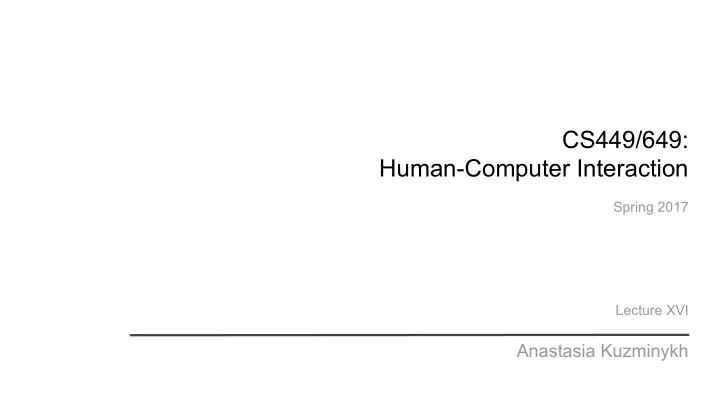

CS449/649: Human-Computer Interaction Spring 2017 Lecture XVI Anastasia Kuzminykh
History of user centered User Centered Design Course Review design in HCI Process July 12, July 17 June 19, June 21 May 1 - June 14 Academic HCI Presentation 2 June 26, June 28 July 19 Last class Special topics in HCI July 24 July 5, July 10
History Waterfall Agile GUI and WIMP Model Development User Centered Design in Computer Systems Cognitive Interaction HFE and Psychology Design Ergonomics Socio-Technical Cooperative Systems Design Design
History Waterfall Model The first mentioning: The first formal description: Herbert D. Benington, Winston W. Royce, Symposium on advanced programming "Managing the Development of Large methods for digital computers, 1956 Software Systems", 1970
History Waterfall Model The first formal description: Winston W. Royce, "Managing the Development of Large Software Systems", 1970
History Waterfall Model The first formal description: Winston W. Royce, "Managing the Development of Large Software Systems", 1970 Additional requirements: 1. Program design comes first 2. Document the Design 3. Do it twice 4. Plan, Control and Monitor Testing 5. Involve the Customer
History Waterfall Agile GUI and WIMP Model Development User Centered Design in Computer Systems Cognitive Interaction HFE and Psychology Design Ergonomics Socio-Technical Cooperative Systems Design Design
History NLS - oN-Line System - developed by Douglas Engelbart and his colleagues at the Augmentation Research Center, SRI First demonstrated December 19, 1968 at the Fall Joint Computer Conference, San Francisco. Was called “The mother of all demos” “We were not just building a tool, we were designing an entire system for working with knowledge.” Douglas Engelbart Image source: UXPlus
History Bill English with several ergonomic setups for the oNLine Doug Engelbart at an NLS workstation System (NLS); late 1960s
DATAR Trackball, 1952 Doug Engelbart’s mouse prototype, 1968 PARC 5-key Chord Keyboard Hypertext Editing System (HES) console, 1969
History Dynabook by Alan Kay, "A personal computer for children of all ages", 1972 Concept of a portable educational device. Target audience was children. “If the computer is to be truly ‘personal’, adult and child users must be able to get it to perform useful activities without resorting to the services of an expert. Simple tasks must be simple, and complex ones must be possible.” Alan Kay Model of the Dynabook
History Developed at Xerox PARC, inspired by NLS and Dynabook First computer to support operating system using GUI, used bitmap display, first to use an early version of the desktop metaphor “If our theories about the utility of cheap, powerful personal computers are correct, we should be able to demonstrate them convincingly on Alto,” Butler Lampson PARC’s Alto computer, 1973 Xerox Alto GUI
History Gypsy - the first document Bravo - the first WYSIWYG preparation program to use document preparation mouse as a point-and-click program, 1974 interface tool, 1975 Tim Mott and Larry Tesler Tim Mott’s sketch of a desktop on a bar napkin, From: Bill Moggridge and Bill Atkinson. Designing interactions.
History Apple Lisa (1983) Apple Macintosh (1984)
History Osborne 1 computer, 1981 Texas Instruments Silent 700, 1973
History Designed by Bill Moggridge and John Ellenby First laptop computer, clamshell design, easy-to-read screen, allowing full 80x24 text, used graphical GRID-OS, no mouse GRiD Compass 1101 , 1982
History Waterfall Agile GUI and WIMP Model Development User Centered Design in Computer Systems Cognitive Interaction HFE and Psychology Design Ergonomics Socio-Technical Cooperative Systems Design Design
History Agile Development The Manifesto for Agile Software Development, 2001 Focus on Individuals Continues process of and Interactions Customer Collaboration Responsiveness to Changes Presenting Working Software and Continuous Development
History Agile Development Principles ● Customer satisfaction by early and ● Working software is the principal measure of continuous delivery of valuable software progress ● Welcome changing requirements, even in ● Sustainable development, able to maintain a late development constant pace ● Working software is delivered frequently ● Continuous attention to technical excellence (weeks rather than months) and good design ● Close, daily cooperation between business ● Simplicity—the art of maximizing the amount of people and developers work not done—is essential ● Projects are built around motivated ● Best architectures, requirements, and designs individuals, who should be trusted emerge from self-organizing teams ● Face-to-face conversation is the best form ● Regularly, the team reflects on how to become of communication (co-location) more effective, and adjusts accordingly
History Waterfall Agile GUI and WIMP Model Development User Centered Design in Computer Systems Cognitive Interaction HFE and Psychology Design Ergonomics Socio-Technical Cooperative Systems Design Design
Week 8 take-away - Stages of the development of a technology - Concept of digital natives and immigrants - Ergonomics: history and influence - Socio-Technical Systems Design: history and principles - Cognitive psychology influence Names: - Cooperative (participatory) design approach - Douglas Engelbart - Interaction Design - Bill Moggridge - Waterfall model - Winston Royce - NLS and “The Mother of all demos” - Alan Kay - Dynabook - Butler Lampson - Xerox Alto, Lisa, Mac - Tim Mott - Personal portable computers - Larry Tesler - Agile development values and principles
Recommend
More recommend